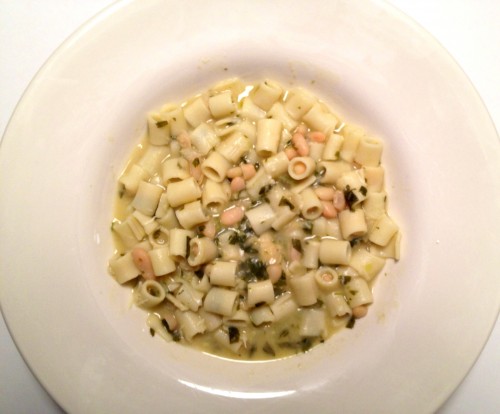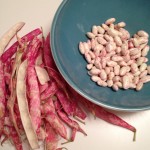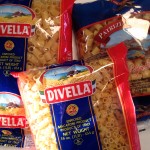A Note to My Readers — Part 3
In learning to cook, I find that I am learning to think, in recipe form. That’s different from cooking per se, because a recipe is communication, a medium that’s supposed to outlive a Tweet, or a chef.
It’s also not supposed to hurt you:
Place the unopened cans — yes, unopened — in a pot of boiling water, perhaps on top of a washcloth so that they don’t rattle. Cover the pot and simmer for two and a half or three hours, taking care to replenish the water as needed to keep the cans submerged: if it boils dry, the cans (I am told) can burst. — Edward Schneider, New York Times “Diner’s Journal,” March 27, 2008
Those weapons are evaporated milk, and I’m still amazed the copy desk allowed them. The resulting dessert, if not immediately fatal, looks like a caramel turd.
Recipes can do other kinds of damage: as I’ve written before, “Lobster à la Riseholme” may get you and your friends swept out to sea.
Sorry, mio caro readerino, if the above reference is obscure, but there’s a select bunch of us who know just what I mean, because we belong to the Mapp & Lucia Club. If you are among the blessed who have not yet had the exquisite pleasure of reading E. F. Benson’s droll, satiric tales of ’20s and ’30s provincial English life, I hope this explanation tempts you as much as a certain shellfish casserole tempted Miss Mapp.
As you will learn, hostess Emmeline Lucas, the formidable Lu-CHEE-ah, broke a rule of her adopted village, Tilling, which is to share any recipe requested during the charming dinner at which it is served. Queen Lucia refused and would soon pay the piper.
Yet, as family cooks across the world know, there is a sneaky way to retain recipe dominance without pulling a Lucia, which is to offer your renowned Pole Bean Surprise to all comers — with one crucial ingredient “forgotten.” How private your glee! But that gloat-worthy strategy backfires if the deficient recipe cooks up better than the original, turning you, its cunning editor, into an object of gentle community pity.
Vazool, the Analysis
In the last half year, the period of my writing rest, I have cooked more than a dozen pasta vazools/fagiolis, searching for the soup that would time-travel me to a pungent, elusive moment. I don’t mean to be clever about this or in any way coy. It’s just that my particular fountain of youth spurts pasta and beans.
Our un-Italian mom cooked pots of meatball-stuffed artichokes, drowned in all-day Brooklyn-Sicilian tomato sauce, and my brother and I disassembled and devoured our suppers as only ravenous children could. (In the ’50s, we watched Spanky and Alfalfa on our Zenith black-and-white, and here’s the pertinent Little Rascals quote: “It might have choked Artie, but it ain’t gonna choke Stymie.”) But even in my fond, red-handed recall I see no white table, no glasses, no light.
No dark and handsome man holding a bowl.
You are combining seasoned beans, broth and pasta. The historically preferred beans are fleshy, speckled borlotti, sometimes termed Roman beans and close relative to cranberry beans, which may be found fresh in smart markets; starchy navy beans, also called haricot or pea beans; easy cannellini; kidney beans, red or white.
Broths can be plain water; water the beans are boiled in if they’re not from a can; decanted pasta water; vegetable, chicken, beef broth, homemade or not.
Preferred pastas vary. Some cooks like leftover clips of pastas past, a fresh or dried assortment called pasta mista; little tubes of ditali, ditalini, paternosti lisci, mezzo canneroni or others, which pretty much match the size of the beans; any smallish shape that’s not a strand or ribbon. I have gathered that the idea is democratic, to give bean and pasta the same voting weight in a spoon.
In the photo at top, you see a lucky cannellini completely embraced by an equally favored ditali. That’s the affectionate, even erotic, goal.
Six other necessaries: olive oil, garlic, onion, salt, red pepper flakes, Parmigiano-Reggiano or similar cheese. Then, almost as necessary, bay leaf; parsley; some form of tomato; pancetta or pork fat. After those, recipes have swung wild, adding celery and carrots; all sorts of pepper, especially sweet Italian; herbs such as thyme, rosemary, oregano, even sage; red or white wine, or their vinegars; Marcella’s “little” pork chops … you get the picture. My juggling tests gave us a few soups that guests enjoyed (ripe plum tomato adds color and puckering sweetness) and others that they did not (too much carrot turns the banquet stodgy).
One more decision: cook pasta separately and add before serving, maybe spooning in some pasta water if the soup has turned to porridge? Or should you, as some recipes demand, throw pasta into the final brew and boil until just past al dente? The second option guarantees a future mush, so I prefer the first, two-pot dish, whether the pasta is fresh or dried.
At the end of this fattening experiment, my focus narrowed, so I offer you not the best pasta vazool, because there are so many, but a simple soup that comes close to twinning the one that awakened me 60 years ago.
Vazool, the Recipe
It will serve 4, but extends easily to 6. All measurements are approximate, because this recipe doesn’t depend upon exactitude, just step-by-step balance. The bean soak takes at least 6 hours, the rest of the cooking about 90 minutes or less.
- 1 pound dried cannellini beans
- 1 pound ditali (or any of those pastas named above)
- 2 bay leaves
- 1/2 cup or more olive oil
- one large yellow onion, chopped
- one large bulb (yes, bulb, not clove) of garlic, cloves peeled and sliced or minced
- dried red pepper flakes
- coarsely ground black pepper
- 1/2 bunch Italian parsley with stems, washed, dried, and chopped somewhere between coarse and fine. Stem pieces shouldn’t be longer than 1/2 inch.
- Parmigiano-Reggiano cheese for grating
- 1 or 2 pieces Parmigiano-Reggiano rind, optional
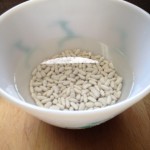 Rinse the beans in a colander, slide into a large bowl, then cover with 1 or 2 inches of cold water. Do this after breakfast for a soup supper. They begin to wrinkle, then swell, as the water penetrates. Stir at noon, add more water if necessary.
Rinse the beans in a colander, slide into a large bowl, then cover with 1 or 2 inches of cold water. Do this after breakfast for a soup supper. They begin to wrinkle, then swell, as the water penetrates. Stir at noon, add more water if necessary.
After 6 to 8 hours, pour into colander, rinse with cold water, put beans into a large pot or saucepan, fill with cold water to at least 2 inches over bean level, and set on high heat, keeping an eye on it until it just begins to boil. Lower heat so it almost roils, and skim foam or not, it really doesn’t make any difference. Add bay leaves.
Stir occasionally, and check to see that there’s at least an inch of liquid — which should be turning cloudy, picking up beanness. Add water as needed.
In the meantime, heat olive oil in a medium-size saucepan to medium-hot and add chopped onion, stirring till it softens, about 5 minutes. Add garlic, stirring for just a minute until it gives up its aroma, being careful not to let it approach the browning point — reduce heat if you must. Burning the garlic is probably the only way you can ruin the soup.
Add chopped parsley and stir all together, letting it wilt. Add oil if you see any chance that the garlic will burn. (You may add the garlic after the parsley, but you risk rawness.)
Toss in red pepper flakes, a pinch or more of good salt, a couple of twists of the pepper mill, stir. Remove from heat.
The Beans: About an hour after you began boiling the beans, scoop out two cups or more of the hot bean water and put aside. Then taste one bean. If it’s lost all resistance, take a wooden spoon or potato masher and start to crush some beans against the pot (you can take it off the heat). Stir and blend. The bean starch will bloom to make a thicker, flavorful broth. Add a teaspoon or so of salt plus water to keep the level constant.
Now, the next step may seem counterintuitive, but it works fine, and if the pan you sautéed the onion mix in is enormous, you can do the pour the other way around.
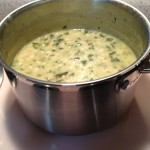 Scrape the onion, garlic, parsley into the hot pot of beans. Use some bean water to rinse the oil and bits out of the pan and into the pot. Stir what now begins to look like pasta vazool. Return to a reduced heat to keep it below a simmer. The soup should be a lovely light yellow, with bits of fresh dark green. Add water or reserved bean water if too thick.
Scrape the onion, garlic, parsley into the hot pot of beans. Use some bean water to rinse the oil and bits out of the pan and into the pot. Stir what now begins to look like pasta vazool. Return to a reduced heat to keep it below a simmer. The soup should be a lovely light yellow, with bits of fresh dark green. Add water or reserved bean water if too thick.
Add optional cheese rinds and stir the pot.
Not too long before you want to sit down and eat, boil ditali for 9 to 10 minutes in salted water. Scoop out a few cups of pasta water and put aside. Loosely drain the pasta and throw it immediately into the soup, stirring. Taste and “adjust seasoning” — I’ve always loved the minor drama implicit in that phrase.
If it’s thicker than you like, add either of the reserved liquids, or water, heat and stir well. Pasta vazool is a “stretcher,” sponging up and growing with whatever you throw in, which should make any frugal household happy.
Serve hot or warm with grated Parmigiano-Reggiano; if you use rind, you may not need additional cheese. (Don’t forget to dig out the soft pieces at the end, they’re a revolting surprise. And the bay leaves, too.)
If you are cooking more than you mean to eat the first night, don’t add the cooked pasta all at once. Put a smaller amount in each soup bowl or mix what you need with the beans in yet another pot (a lot of washing): the bean-to-pasta ratio is one to one. Otherwise, the pasta softens and makes leftover soup a gruel.
By the way, the bean part of the vazool saves for days in the fridge, and even freezes, so you can pasta it up right before you eat.
Vazool, the Coda …
Or the postscript, because a recipe looks to be a linear narrative — at first. But then it picks up a few of the tricks that literature flings on gullible readers/eaters: the flashback, the story within the story, the omniscient and, my favorite, the unreliable narrator. So here are three writing lessons learned on my soup trek:
The hard bean is as sensitive to its surroundings as a baby.
Cooking may mean controlling the speed of thickening, of change, and on top of that, the gentle wooing-out of flavor in the process. A recipe, therefore, is courtship advice from a matchmaker.
Garlic is my madeleine.

